Freight Operations - Non Passenger Coaching Stock -
Milk
For a good overview of the whole business of supplying milk to the towns
a visit to the National Dairy Museum, Wellington Country Park, Riselley,
Reading RG1 3OH (Tel: 01734 390918) is worth considering.
For more information on milk deliveries see Appendix One - Civic and Commercial Life, Public Buildings, Shops, Traders and Tradesmen - Traders delivery vehicles and mobile shops .
For more information on modelling daries and creameries see also Linside Industries - Daries and creameries.
Outline History
Cows produce
milk twice a day, sometimes three times a day in high season and this has to be distributed fairly quickly. The railways carried milk into the larger towns from the early 1830's but in the latter
part of the 19th century there were still large herds kept in cities such as
London to provide milk for the inhabitants. As discussed in the historical
background section an outbreak of cattle disease and the advent of the railway changed
all this, rail travel meant that the milk could be brought in quickly and
cheaply to the towns from the country. First in the field was Express Dairies (1871),
who chose their name to emphasis the railway connection, followed by various other milk marketing organisations, often local co-operatives operated by farmers. The other large companies involved in rail supplied milk included United
Dairies (formed by a merger of Metropolitan and Great Western Dairies, the Wiltshire United Dairies and The Dairy Supply Company in 1917), Independent Milk Supplies and of course the Co-Op. In 1959 United Dairies merged with Cow and Gate to form Unigate although both prior names remained in use.
By 1883 one farmer alone was
sending 19,000 gallons a year to Birmingham and by the late 1880's entire
trains of milk churn vans were a feature of railway operations.
All the four Pre-Nationalisation companies carried milk traffic, the GWR had
the largest share, followed by the LMS then the Southern, serving areas of
Somerset and Devon and the Somerset & Dorset line. The LNER carried the
smallest share, mainly milk produced in East Anglia.
Up to the Second World War most milk was sold raw, that is it
was not 'pasteurised'. In the towns (and in the country areas) the churns were
loaded onto horse drawn two-wheeled milk 'floats'. These had large wheels, say
four or five foot in diameter but mounted on a U shaped axle, allowing a lower
than normal floor on which the churn was carried. People went out with their
milk jugs to collect a pint, measured out with a long handled tubular metal
ladle.
Bottled milk first appeared in the 1880s, the earliest reference I have found quotes their introduction as 1880 by express daries, another claims it was 1884 in Northern Ireland and several references quote 1900 for England, this being for pasteurised milk only. The bottle making process was only partly automated at that time, fully automatic bottle making was developed by an Irishman called Michael Owens in 1903 and this provided the impetus for the rapid expansion of the bottled milk market.
Bottled milk became commonplace from about 1930, although it was generally
confined to larger towns. Horse drawn milk floats for bottled milk were in use by the time of the First World War, and by the 1930s electrically powered floats were in use. The electric vehicles were common in towns by the later 1930's but horse drawn milk floats remained in widespread use (one was still in use in South
Manchester in the late 1980's).
Pasteurisation has nothing to do with
'pastures', it is a process named after its inventor Louis Pasteur, the chap
who also invented vaccinations. In pasteurisation the milk is heated to kill
bacteria, it is a valuable protection against various disease carried by cattle
that can infect people. It was introduced in the 1890's but took a long time to
become the norm. One problem was determining the time and temperatures
required, if these are wrong it starts the spoiling process in the milk. Modern
practice uses temperatures of between 80 and 88 degrees centigrade maintained
for a period of between 20 and 40 seconds, this is called 'flash
pasteurisation'. Sterilised or UHT (Ultra Heat Treated) milk is heated at higher temperatures and greater
pressure for a longer time and will last longer without
refrigeration.
The Milk Marketing
Board (MMB) had been set up in 1933 to ensure supplies of affordable milk were
available throughout the country. The MMB bought all the milk from the
suppliers and sold it on at a standard price to retailers. By 1948 the MMB was collecting milk from 130,000 farmers, using
some 500,000 ten gallon milk churns and delivering to about 10,000
destinations, mainly dairies but also chocolate factories, dried milk factories
and other users. Rationalisation reduced the number of individual consumer
locations supplied to 496 by 1972. Pressure from the MMB meant that by the end
of that decade the once commonplace churns had disappeared, replaced by
bulk handling and chilling equipment on the farms.
The quantity of milk moved by rail has
fallen steadily over the years, from 282 million gallons in 1923 to 230 million
gallons in 1929 and by 1969 there were only two major milk runs of two trains a
day in regular operation, one from Fishguard the other from Devon &
Cornwall, all destined for London. It is worth noting however that this was
still some 70 million gallons and accounted for some 25 per cent of the total
milk moved. This contract was finally lost in May 1980, and the trade is now
carried entirely by fleets of road tankers. In the later 1980's I contacted the MMB who told me they had a fleet of rail tank wagons in reserve but rail transport was only
used when milk had to be moved a great distance (milk is only moved 70 to 100
miles by road), or when road transport presents difficulties such as in bad
winters. As far as I am aware the road-rail tanks fell out of use in the 1960's.
One oddity of the milk trade was the problem of disposing of the whey from the milk and with the introduction of the country creamary one solution was to set up pig farms and feed the whey to the pigs. The resulting pork and bacon would then form traffic for the local goods yard (as far as I am aware the meat was not handled at the creamery siding but I could be wrong on that point).
Churns and Tanks
Milk was originally distributed in 'pails', buckets (I believe they had lids), the vendor (usually a woman, hence 'milk maid') carried two of these on either end of a wooden yoke. Customers would bring out their milk jugs and the vendor would use a ladle to dispense the milk. Once the railways started carrying milk the pail proved less than ideal as it was top-heavy and tended to spill. The farmers used a tall conical wooden container to 'churn' the milk to make butter, this was made up of staves bound with metal hoops (technically a 'cask') and this proved to be preferable for the railways to transport. It held a lot more milk (about seventeen gallons) and its conical shape made it less likely to spill or fall over. These wooden churns were intrinsically heavy however and from the 1850's a steel version was introduced and soon became the standard. The name churn was retained for these containers (the Americans called them 'cans') although they were not used for making butter.
The milk churn was a standard size, the older
galvanised iron conical type held 17 gallons, the cylindrical type with the mushroom shaped lid
introduced in the 1930's held ten gallons. Each churn carried a brass plate
near the top to identify the owning company and when full it would have a white
paper label (tied to the handle on the lid of the conical type and to the side
handle of the cylindrical type), which was used for accounting purposes by the
dairy.
Milk churns were heavy so the normal practice was to tilt them on one side and roll them along, the sketch shows both the older conical churn and the later cylindrical type being moved in this way.
Fig___ Milk churns
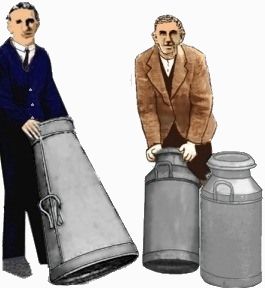
The milk
churns were loaded into the milk vans from the station platforms, a farm hand
assisting a porter was the normal practice. On the platform they often sat in
the shade on small 4 wheeled trolleys, such as those offered in the old Triang
Trebleo-Lectric figure sets. These sets are still being marketed, although
presumably old stock. Note the loaded churns would all have a white paper label
attached to one of the handles.
In the late 1920's there was a change in the way milk was handled by rail with the introduction of insulated 3,000 gallon rail tanks to
supply milk to the larger towns. The LNER estimated that a small fleet of seven
tanks they provided for Express Dairies replaced over two thousand churns on
the run to London. A single tank wagon would supply enough milk for
some 35,000 people so smaller towns continued to be supplied with churns up to
the end of the Second World War. Rail and road/rail milk tank wagons and their liveries are
considered in greater detail below.
The milk churns remained part of the railway scene into
the 1960's, possibly the 1970's, bringing the milk from the farms to the
country dairy and also travelling to the smaller towns and communities along
the line. Milk churns remained the principal method of collecting milk from
farms for many years. In about 1966 the MMB pressed farmers to invest in
cooling vats and bulk handling equipment and by the mid 1970's most milk was
being collected from farms in road tanker lorries. The last churn collection by the England and Wales Milk Marketing Board (by lorry for road delivery) was in 1979, I am not sure when the Scottish MMB (always a separate organisation) ceased accepting churns.
Rolling stock used with churns
Initially milk traffic consisted of wooden churns of milk, made up from staves held with iron bands (the same method as used for barrels) usually carried in vans attached to passenger trains or in the guards compartment. Following the rapid expansion of the traffic in the 1870's purpose built milk churn vans appeared attached to
passenger trains and by this time the galvanised iron conical churn was the norm. These vans often had alternate planks 'missing' to provide a
slatted appearance, allowing air to flow over the churns in transit to keep it
cool.
Fig___ Early milk churn vans
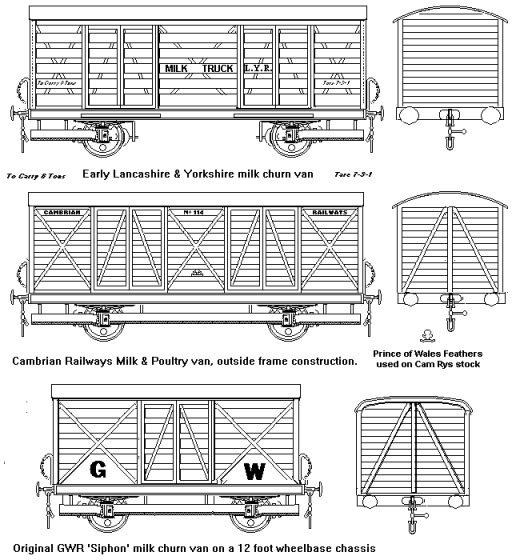
Modelling the
Cambrian and L&Y vans was described in Railway Modeller Jan 2001 Traffic
for Tickling Article 1 - Milk Train. My model is a freelance effort taking
elements that I liked from both. It is based on a Peco pallet van kit and runs
on a Peco brake van chassis which is appropriate for these
vans.
Fig___ Home made four wheeled coach and milk churn
van

The
milk churn vans were also used for fruit and veg traffic and some essentially
similar vans were built with cambered floors to handle fresh fish
in cases and small barrels. There is a photograph of a GWR six wheeled slatted
siphon van, clearly marked as being for fish traffic only, being loaded with
milk churns in the HMRS book `Great Western Way'.
The GWR standard six wheeled slatted vans,
coded 'siphon' are probably the most familiar to modellers, but many companies
operated similar slatted designs on four and six wheeled chassis.
Fig___ GWR 6 wheeled milk churn vans
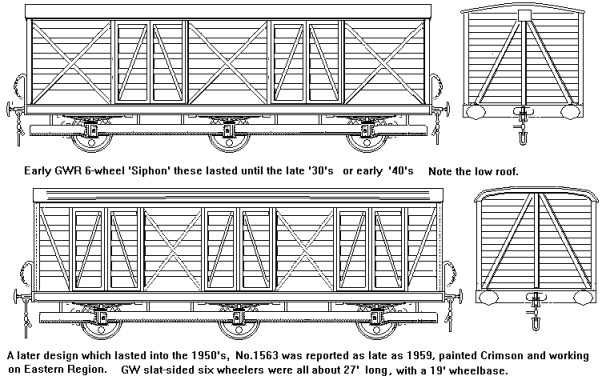
Some milk vans had
solid sides fitted with ventilating louvers usually in their upper sides (an
example of this is the Lima Great Western Railway Siphon G). With the decline
in milk churn traffic these were re-deployed for general parcels duties, in
some cases they were permanently `converted' for this use by boarding over the
louvers. The GWR
siphon C shown here can be modelled (with some difficulty) on a Graham Farish
four wheeled coach chassis.
Fig___ Louvered sided milk churn van

Some pre-war slat-sided and louvered
siphon vans were transferred to 'departmental' use, after 1947 these had the
word ENPARTS in large letters on the side and they carried spare parts for the
engineers about the railway system. The slat-sided enparts vans were all
withdrawn by about 1950 but Lima offered their Siphon G in the rail blue
'enparts' livery introduced in the late 1960's.
Not all milk churn vans
were ventilated, some had solid sides and used ice and later frozen carbon
dioxide (or 'dry ice') for cooling. The sketch below shows such a van built by
the GWR and coded Siphon J. These were introduced following experiments with
that companies insulated four wheeled vans, coded MICA and originally built for
meat traffic. The siphon J's were eventually used as a parcels vans by
BR.
Fig___ Closed sided insulated milk churn van
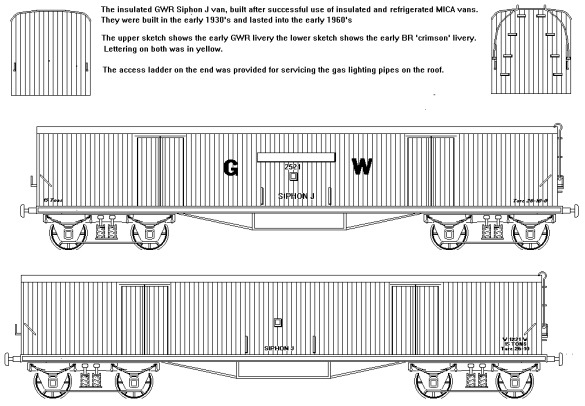
In the 1920's the milk tank wagons appeared, running from the country 'creamaries' to the town daries (or milk depots). The older milk churn vans still
appeared in milk trains however, there might be one or two vans with three tanks and a
brake van forming part of the train. These vans were mainly carrying cream,
butter and other milk products from the country creameries. If the creamery was
at or near to a junction station the milk churns might be used to bring milk
from the stations along the branch line, providing traffic into the works,
whilst most of the milk would then be forwarded on to the major town in tanks.
MilkTank Wagons
Milk tanks were unusual in that the
chassis was provided by the railway company but the tank itself was the
property of the dairy company operating the wagon. A full milk tank weighed as
much as a loaded passenger coach so if you are pulling any number of them you
should have a decent sized loco at the front end. Milk tank wagons on four wheeled chassis arrived on
the GWR and LMS in 1927, followed a year later by the LNER. The SR took up the idea in 1931, although their initial approach was to use road-rail tank trailers carried on four wheeled flat trucks built for the job (these are discussed below). A smaller country creamery would normally load a couple of
tanks a day, a single three thousand gallon tank would supply the daily needs
of about 35,000 people.
Initially these tank wagons ran on four wheeled
chassis.
Fig___ Early milk tank wagon
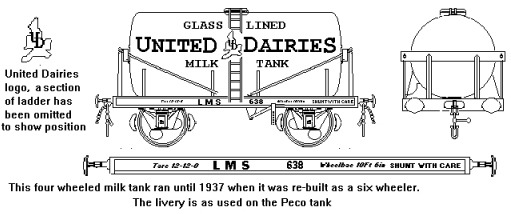
The early tanks had a simple glass-lined (actually it was a vitreous enamel coating on the inside of the tank) barrel with no internal
baffles, this resulted in the milk sloshing about inside the tank which
degraded the milk and made the wagons unstable. Following a series of
derailments a six wheeled chassis was introduced (I believe this was in about 1931), which
gave a smoother ride and six wheelers then became the standard chassis for all new milk
tankers and wagons used for milk tank road trailers, although each company had its own design features. The last of the four wheelers were withdrawn in the later 1930s and six wheeled tanks
continued in production under British Railways into the early 1950's.
The Peco four wheeled tank, available in a number of milk liveries, can be used for late 1920s to the mid to late 1930s layouts or it can be converted into a six wheeler (the details of which can be found on the N Gauge Society website). Dapol have produced an N Gauge six wheeled milk tank wagon in a selection of liveries, however converting a Peco, Minitrix or W&T kit tank wagon to a six wheeler is not terribly difficult. Details of how to do this will be found in the Kit Bashing section.
It should be noted that the Peco tanks are
`Class B' un-lagged types, milk tanks (and many other Class B tanks) were
lagged, and so had a smooth body, such as that supplied with the W&T kit
and the Minitrix 4 wheel tank. The Minitrix model has the dome and ladders as a
separate moulding which can be re-positioned at the end of the tank, a feature
of many of the tanks I have seen in the diesel era. The W&T model has a
separate dome which can be placed anywhere on the body. For tanks with a plain
ladder and no side platforms, either end or side mounted, it is better to
discard the ladders supplied, replace these with lengths of etched brass
'signal laddering' and use the head of a pin for the filling dome.
Peco offer their four wheeler in early Express Daries and United Daries livery, suitable for layouts set up to the mid 1930s. The photographs below show the Dapol six wheeled tank in a selection of liveries, note this company produces models in short runs and in different liveries so you may need to wait a while if you require a particular livery (this does mean that a lot more liveries get produced). I believe the liveries shown in the photographs are all early to mid 1930s, prior to the general simplification of livery in the later 1930s (although examples would have been seen well into the BR era).
Dapol N Gauge milk tank wagons
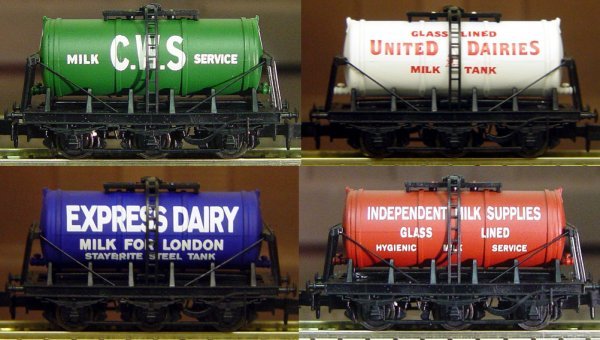
I read somewhere that the
pre-war six wheeled milk tank chassis had a twelve foot wheelbase and was
always vacuum brake fitted. Post war designs appear to have used a thirteen
foot wheelbase chassis and some sources quote this as standard in the 1930s as well, but the difference is impossible to spot from
photographs and I always aim for a basic twelve foot.
The SR and LMS favoured
round section tie-rods between the axle boxes, the GWR had flat strip and the
LNER had none. BR used either the round section or flat strip type tie-bars. I
found home-made plastic tie-bars to be too fragile for my nomadic existence so
I switched to copper wire, hammered flat if strip section is required. This
lasted rather better but I am slowly changing over to using stiff brass 20 thou
wire from Slaters as this is less liable to distortion.
There were many designs of
tanks large and small, some were set at a visible angle to allow easy
unloading. On horizontally mounted tanks the tank access ladder and filling
dome were centrally placed on the tank body but where a sloping tank was fitted
the filling cap was at the higher end. There were variations in the design and
placement of the access ladders and some had top-mounted the catwalks (LMS
designed tanks only) or working platforms near the top of the ladder, with or
without hand rails.
Southern Railway wagons had additional bracing on
the end supports, forming a V shape and they had larger than normal 'dampers'
at the ends of the springs. Microstrip should serve for the additional bracing
but for the dampers the best bet would be to add a blob of Milliput to the ends
of the springs.
Some vehicles carried two separate tanks or a single
tank divided into two compartments to enable segregated loads of two grades to
be shipped. When Channel Islands milk was introduced into the system twin tank
wagons or wagons with two compartments in a single tank were used to separate
this from the domestic product. The GWR had various double tank wagons, one of
the more common designs is illustrated below (Slaters offer a 7mm scale kit of this version, their catalogue shows it in all-over red livery with rather ornate gold lettering for a London Co-Op).
Fig ___ Distinctive
Big-Four Milk Tank Wagons

Over the years over 600 6 wheeled milk tank wagons were built, the chassis was painted
in the railway company livery, including its logo, and carried the number, the
wheel base, the instruction `NOT TO BE LOOSE OR HUMP SHUNTED', fast traffic
stars and the tare weight of the wagon. However the location of these markings
varied somewhat and not all the tanks carried the fast traffic stars (non of
the BR tanks I have seen photographs of have these, nor do any of the
immediately pre-war GWR tanks).
The GWR produced photographs for its
records of new wagons, I have seen one of a four wheeled tank (in a photocopy
of a page from the GWR Magazine, supplied by the GWR Historical Society at
Didcot) and another of a six wheeled type (in B.K. Coopers `Great Western
Railway Handbook'). Both show wagons with a wooden plank painted dark grey or
black mounted on the chassis running the full length of the tank, on which is
painted the number (sans serif, 9 inches high, toward the lower left hand end),
the company initials (sans serif, 12 inches high, to either side of the centre
line) and the tare (italic script, 9 inches high, toward the lower right hand
end). These boards could have been purely for the purposes of the records
however and I do not have any information on wagons with this plank operating
in service.
The early milk tank liveries were quite ornate, mentioning
such things as insulation, hygienic glass lining and with the dairy company
name in full on the sides of the tank. These were gradually simplified over the
years, for example the Lima OO gauge model `IMS' livery was introduced in the
early 1940's, replacing a tank with 'Independent Milk Supplies' in full on the
tank side.
Fig___ Pre war milk tank wagons
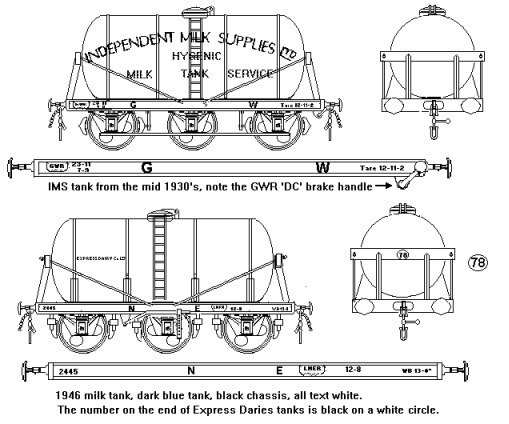
In 1942 the MMB took
over the responsibility for shipping milk and the old dairy liveries gradually
disappeared, most it would seem by simply wearing off the tank. The MMB standard wartime livery was an all-over grey with MMB and MILK on the side in lettering about 4 feet high in plain white. Photographs of
milk tanks in the later war years and early 1950's suggest a sorry state of
affairs with little trace of the original liveries left. Even after the war not all wagons received the MMB standard livery and many remained
in their old colours or had partial MMB livery applied over the top.
The
sketch below shows two tanks, one in late pre-war IMS simplified livery of light blue tank
with white lettering edged in dark blue, the other in post war MMB livery.
These were sketched from photographs in Dave Larkin's book 'BR General Parcels
Rolling Stock' published by D Bradford Barton (see Bibliography) so both were seen in the 1960s. The MMB
example had a pale blue tank with MMB in white shaded dark blue about two foot
high toward the left hand end of the tank and the word MILK in lettering about
one foot high toward the right hand end of the tank, again in white shaded
blue. Beneath the word MILK is the marking MMB126 in plain white about one foot
high. I have also seen a photograph of a model of a milk tanker in rather
similar livery, although the tank itself was silver and the lettering either
black or dark blue and un-shaded, the number in this case being MMB617. This
however was a model and I have not been able to confirm this
livery.
Fig___ Post war IMS and MMB Milk Tanks
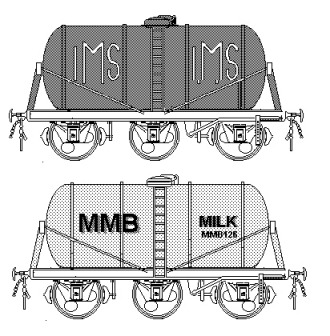
The official standard post-war livery
was a plain silver tank on a black chassis, all markings on both being in
white, however quite a number of tank bodies were painted plain light blue and
some tanks retained the faded remains of earlier liveries though to the 1970's.
The official tank marking consisted of a simple black painted stripe, or plate,
four to six inches high by about three feet long, on which was painted the
dairy company name in white.
In service the `silver' tanks soon dulled
to white (at least they appear white in colour photographs) and these tanks
were often rather grubby with considerable staining and dirt on them (lots of
Humbrol track colour well thinned down). The dairy name often seems to have
worn off, leaving just a dark smudge near one end of the tank.
Fig
___ Some milk tank wagon designs in BR era livery
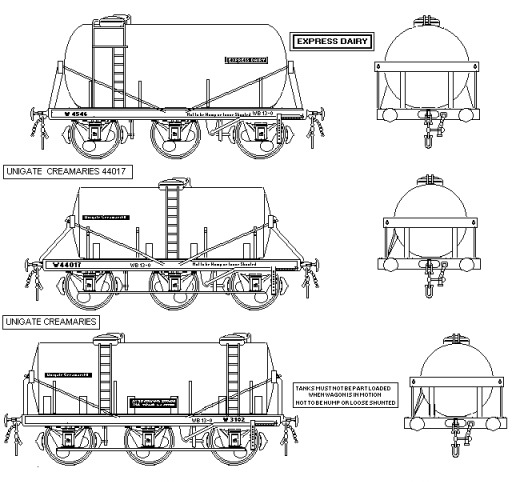
Dapol have now released a rather nice model of a six wheeled milk tank wagon in a number of liveries. The Peco tank comes on a four wheeled chassis, suitable for the period 1927 to about 1937, the Peco chassis can be altered to a 6 wheeled type (there are detailed instructions for doing this on the N Gauge Society website). The larger six wheeled tanks can also be made
from the Minitrix tank wagon, the design of which allows you to re-position the access ladder and hatch toward one end of the tank as seen on some milk tanks. This again requires a modified chassis, and for accuracy you have to delete the
horizontal rail along the tank side as non of the milk tanks appear to have had
this (I forgot this and all mine still have the side rail). The photo shows one of my models, it is many years old now and the plastic tie-bar has been lost, when I re-do these wagons I will remove the side rail and add 20 thou brass wire tie rods.
Fig ___ Minitrix tank converted to milk tank in BR era
livery
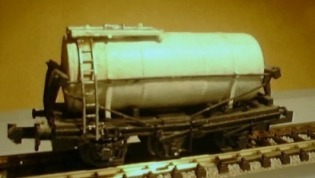
The smaller tanks, which often had rather flat ends, can be made up on an
Peco chassis using a length of tubing as the barrel with the ends
filled with Milliput and sanded to shape or using the Ratio oil tank kit, these come as a pair and you need to cut a section of one tank to extend the body of the other.
By the late 1960's the MMB had
switched entirely to road haulage and only two companies were still using rail
tanks, Express Dairies and 'Unigate' (formed by the merger of Cow & Gate
and United Dairies in the 1960's). The Express Dairies added a number plate to
the cross member at the end of the tank but Unigate generally relied on the
chassis number although on at least one wagon they added the BR wagon number to
the end of their name plate. Older stock was often not re-painted and examples
of rather worn pre-war and MMB liveries were seen into the early
1970's.
Unigate painted some stock in its `St.Ivel' livery, using orange and white. The
design of the St.Ivel logo renders this rather difficult for the conversion
enthusiast but a simplified `livery' of a plain orange tank body was also used
on the larger type of tank in the sketch below (there is a photograph of such a
tank in Mr. Larkin's book taken in 1970). The chassis, ladder and end support
frames were all black and lettering white.
Fig___ St Ivel milk
tanks
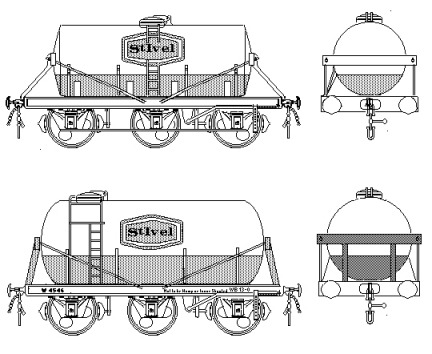
More recently the Milk Marketing
Board have used four wheel and six wheel anchor mounted tanks, the four wheeler could be modelled (with difficulty) on a Peco long wheelbase chassis. The tank was about five foot six inches in diameter with conical ends and anchor mounted with side skirts. The access ladder was mounted near the centre of the tank. The tank body was in Aluminium,
sitting on a light blue skirt, and the chassis was black with orange covers on
the roller bearing axle boxes. These vehicles, both four and six wheeled, were TOPS coded TRV, the BR markings
were in white on black patches, the MMB markings were in white on a light blue
background. These tanks were operated on the Chard-Stowmarket service in 1981, which may well have been their last revenue earning run,
but I have no information on other routes.
Road-Rail Milk Tanks
Two thousand gallon road tankers,
carried on railway flat wagons were introduced in 1931 initially bu the SR and over the years about 60 were built, by all the Big Four, along with their associated wagons. The wagons were generally 6 wheelers with wheelbases ranging from about twelve feet to about fifteen feet (the first batch of the SR wagons were four wheelers but later batches were all six wheelers). Four wheel milk tank wagons remained in use until 1937 and these four wheeled tank carrying wagons may have lasted that long. The earliest evidence I have seen of the road-rail tank in use is an undated photo in Janet Russels book on GWR Company Servants, showing an early type of tank (six spoked wheels) owned by the CWS being loaded on to a GWR four wheeled 'Serpent' carriage truck (this may have been a trial of the idea using one of the SR tanks) but by the late 1930's they were definitely using a six wheeled transporter wagon to a fairly standard design. The earliest dated photo I have found shows a four wheeled road tanker on a six wheeled chassis heading a mixed train of four and six wheeled tank wagons in January 1933.
The road-rail tanks seem to have ended up at the head of the rake, this may have something to do with shunting them from the loading bay, there were quite a few instances where several such wagons were added to a rake, I have seen a coupe of photographs showing two road tank wagons at the head of a rake in the early 1950s.
These road-rail tanks were usually used to collect
milk from a creamery not itself served by the railway, or perhaps from a larger
farm, then loaded onto the flat wagon for shipping to the town. If delivering
to a town dairy they remained on the wagon and were worked in the same way as
the railway milk tanks. Sometimes these road milk tanks would bring in milk
from the country creameries to towns where they could be off-loaded to supply
outlying bottling plants or other industries requiring supplies of milk in
bulk. One example would be a 'condensed milk' factory, the earliest examples of
these I was able to trace date back to the 1890's, so even a branch with no associated creamery or dairy could justify one of the wagons attached to a passenger service for express delivery. Modelling the six wheeled rail wagons is discussed in the section on
Kit Bashing. Road-rail tanks for slower goods trains were carried on four
wheeled chassis, there were several of these used for beer traffic for
example.
All the
pre-nationalisation companies used both the six wheeled milk tanks and the six wheeled road
tank carrying wagons.
The road tanks themselves seem to have been pretty standard in their design, all those I have seen used a cylindrical tank about five feet or so in diameter. Early
road-rail tanks had spoked wheels and solid tyres, a photograph of one of these
is shown in the book ` GWR Company Servants', the
straps securing the tank to the chassis were visible on the outside (later
tanks had the securing straps inside the lagging of the tank, giving a smooth
exterior). On the very early tank there were two axles at the rear of the tank, with two narrow
solid-tyred wheels on each end, and a single swivelling axle at the front,
again with two wheels on each end. These wheels were small, roughly two foot
six inches in diameter and the Airfix or Matchbox World War Two German PzIII
tank road wheels are suitable.
By the mid 1930's fairly modern looking
four wheeled road-rail tanks with pneumatic tyres had
appeared, by the later 1940s these often had mudguards. The LMS added a walkway along the upper part of the tank on the ladder side to their later batches of tanks, however I believe non of the other companies had these.
BR built several designs of road-rail tank wagons, these are well
illustrated in the book GWR Company Servants and further information can be
found in the book BR Freight Wagons by Don Rowlands, both of which are
discussed the bibliography. Modelling the road tanks is further discussed in
the section on 'Kit Bashing'.
Fig ___ Sketch of road-rail milk
tanks
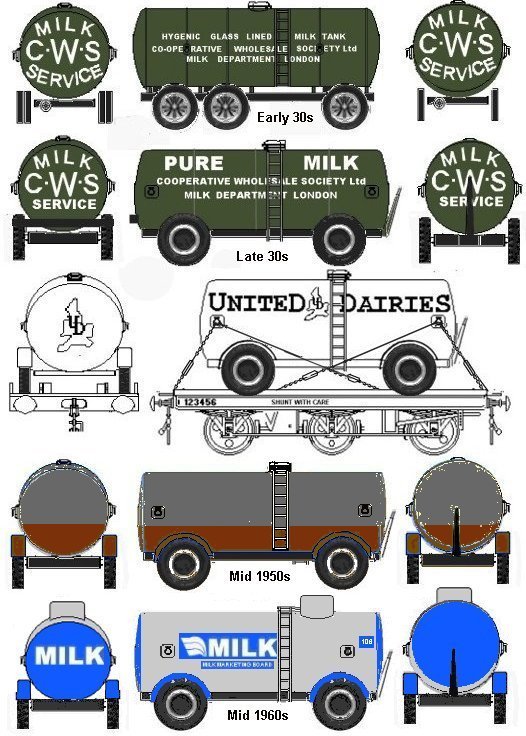
I am not certain of the colours used for road-rail milk tanks although I believe the chassis in all cases was black. In the sketch the top tank is based on a photo in Janet Russels book on GWR Company Servants, the photo was taken in the very early 1930's. The end is correct but the upper and lower lines of text on the side are largely guesswork. I am not sure of the body colour, possibly dark green or possibly dark blue. The wheels are about eighteen inches in diameter. The second tank lettering is correct (taken from a photograph found on a motoring history website, the address of which I have lost), dated about 1936 I believe but again I am not sure of the colours. The wheels are two foot diameter and there are no mud guards. The third tank livery is from my notebook and may well be incorrect, by the later 1930's simple flat metal mud guards were in use. The sketch shows the method of securing the tank to the wagon. The grey and brown tank is sketched from a photograph found on the internet, I am not sure of the upper body colour but this was probably wartime grey or possibly MMB light blue. The silver tank is based on a sketch in my notebook, I am not sure about this livery but if my notes are correct it is a silver bodied tank with white lettering on blue patches and with all blue ends carrying white lettering. The mudguards were by this time (late 1950's or early 1960s) pressed steel cupping the top of the wheel.
Milk Train Formations
Milk was brought in along the branch lines by the 'milk trains', often with a
passenger coach or two attached, each rake of churn vans or tanks having a
brake coach on the rear. These were delivered to the creameries on the main
line, or where the creamery was some way up the branch the milk it had
processed (usually in tank wagons) could be just tagged on to the express milk
train at the junctions with the main line.
Standard four-wheeled
passenger brake vans were commonly used for these trains but the four wheeler
GWR milk brake coaches were converted pharmacy coaches built for service in the
First World War. These GWR milk brake vans can be produced from a Graham Farish
4-wheeler with a bit of filling and carving.
Fig___ GWR Milk Brake
Van
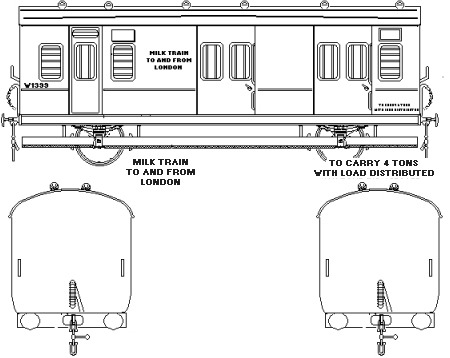
Milk by its very nature was scheduled to run at passenger
speeds, and the early morning `Milk Train' was a feature of British life until
the late 1960's. These often formed the first passenger service of the day on a
branch line, a couple of coaches with some siphon vans, milk tanks or a mix of
both attached to the rear. After 1959 four and six wheeled vehicles were banned from passenger trains, the milk train still ran but without the passenger coaches attached. Not all milk trains running down a branch line had a passenger coach attached,
some consisted of just milk vans or tanks and a goods brake van on the rear. Three thousand gallons of milk weighs in at about 13 tons, the tank wagons themselves had a typical tare weight of around 12 tons, this gives an all up weight of around 25 tons but the narrow gauge Leek & Manifold Light Railway used its transporter wagons to carry at least one standard gauge milk tank from the junction with the North Staffs Railway up the line to the Ecton Dairy.
Up to the 1960's milk
was shipped anything up to 250 miles by rail, as most milk is produced on the
western side of the country, where most of the rain falls, the routes were
generally east-west. London was the main destination for railway hauled milk
but all major towns and cities would have some of their milk brought in by
rail. Milk for London was shipped from as far north as Carlisle (via the Settle
& Carlisle route to the Express Dairies depot in Hendon) and as far west as
Fishguard, which is at the lower western corner of Wales. The long haul milk
trains would collect additional milk tanks at various junctions en route. The
term `milk run' became synonymous with a routine trip where the timetable was
set and remained unaltered.
One such `milk run' was from Long Rock near
Penzance, to St. Erith where some tanks were collected from the local creamery,
then to Lost Withiel, again collecting local milk tanks, Totness where there
was a local creamery and also the tanks from the Ashburton branch, thence to
Exeter where rakes of tanks and milk vans, each with a brake coach attached,
were added to the train from the Hemyock and Torrington branches. The train
then went via Tiverton Junction as an express behind a King, Castle or Star
class loco to Kensington, a typical make up by this time being 10 or 12
6-wheeled tanks, a siphon or two, with odd milk brake coach or passenger brake
coach interspersed along the rake and a passenger full brake on the
end.
Later, with the advent of dieselisation, the loco might be one of
the Western Region `Western' type locomotives, the train consisting of 20
tanks, interspersed with siphons and passenger full brake coaches and with a
full brake coach on the tail.
Additional Information
I answered a question on uk.rec.models.rail newsgroup and the other comments on this thread proved interesting. The following is a summary of those responses.
When I knew them (in the 1970s) the few surviving trains ran from
West Wales and Devon and Cornwall. The tanks were loaded at some kind
of central collection point with its own siding and taken overnight to
London, where the milk would have been bottled. I think processing
(pasteurisation etc.) would have been done at the collection and
loading point.
The milk was transported in six-wheeled tank wagons which - I think -
usually bore the name of the milk company - United Dairies or St.Ivel.
My impression was that trains consisted exclusively of milk tanks with
no other kinds of vehicle.
Some loading points were located on branch lines at places such as
Hemyock and Torrington, and a couple of places near Lampeter in West
Wales. Several branch lines survived for many years after the loss of
their passenger trains exclusively for the carriage of milk.
Branch-line trains would have been hauled by smaller diesels such as
Classes 22, 25. or 35. The trains were taken over by larger loco's -
typically a Class 52 "Western" for the main-line run to London. Tanks
from several loading points might have been combined at Exeter and
other major stations into longer trains for the main-line run.
In steam days (at least post-war) things were similar. Milk trains
were generally hauled by quite prestigious main-line passenger
locomotives such as Castles, Counties and even Kings.
before the introduction of tank wagons, milk was transported in metal
churns, often in slat-sided vans. The churns were generally loaded
onto the trains at the passenger platforms.
I hope this is enlightening
~ Andy Kirkham - Glasgow
You could try to obtain a copy of "Great Western Branch Line Termini"
Volume 1 by Paul Karau ( Guild Publishing London or reprinted by
Oxford Publishing Co.)
In the section dealing with Hemyock, there are some nice pix together
with details of the strange working practices for shunting milk tanker
wagons. I worked on a farm at nearby Culmstock during the last years
of steam working on the branch and was often held up while they were
'shunting' the tank wagons across the road. Looked a bit 'dicey' to
me even then!
~ Glanville Carleton
I'm fairly certain that the West Wales
tanks started from Whitland, picking up at Carmarthen, where there were two
dairies as well as the traffic from Pont Llanio and the other plant up that
way, and finally at a siding at Marshfield (between Cardiff and Newport).
There was no dairy here, the tanks being filled directly from road tankers-
don't know how they steam-cleaned the wagons. The tanks were almost always
filthy externally, and carried a strong odour of rancid milk around them.
Milk is still carried by rail- on Mansel Davies road tankers that go via the
Channel Tunnel, and also in insulated containers that travel from various
locations in Northern France to Italy for cheese-making.
Completely by chance, I found myself talking to the landlord of the Three
Horseshoes in Burbage last night- he had started work as a teenager in the
Merton dairy, and remembered the milk trains.
Stephen Poole's recent book on his career with BR has quite a bit in it
about the running of the milk trains in their latter days
~ Brian Williams
Being brought up in S W Wales, the milk train was a feature of daily life,
passing just as I walked home from school. Whilst the 'trunk' service that
started from Whitland was composed only of tanks, that from Pont Llanio,near
Newcastle Emlyn, sometimes included coal wagons from the yard at the
terminus.
Regarding the unloading end of things, most terminals (Merton, Cricklewood
etc) were simple private sidings. However, one notable exception was the
dairy at Vauxhall, the first station after Waterloo- here the wagons were
stopped on one of the platforms, and hoses connected to them- the pipes
disappeared below the platforms- I can imagine the environmental health and
HSE people would throw a wobbly if someone proposed this today- third-rail
electrification, pipes trailing everywhere etc.
A decent R-T-R six wheel tank would go very well with the Heljan Western
when it arrives...
~ Brian Williams
In the period I remember (late 1950s), there were paths for four daily
milk trains from West Wales to London. These were the 3.50pm, 5.15pm and
8.30pm from Whitland to Kensington and the 6.45pm from Carmarthen to Wood
Lane- Times varied slightly from year to year. The 5.15pm and 8.30pm from
Whitland were conditional, depending on amount of traffic on offer. These
trains sometimes started from Carmarthen, which originated traffic from
four dairies - Pont Llanio and Felin Fach on the Aberystwyth line, plus
the two at Carmarthen. The trains invariably included a GWR passenger full
brake and sometimes carried road trailers in addition to the usual six
wheel tank wagons. Usual motive power for all four trains was a Castle,
although the 3.50pm was sometimes worked by a King forward from Swindon.
Engine workings were shared by Old Oak (81A), Swindon (82C), Canton (86C),
Landore (87E) and Carmarthen (87G) sheds. Milk traffic was very lucrative
and was given equal priority to the best passenger trains.
~ David
By the time when I started taking an interest in trains (coincident with my
going to Llanelli Boys' Grammar, which had a first-class view of the line
from the science and geography rooms), there was but one train that I knew
of, which passed Llanelli at about 16:00. It was almost invariably headed by
a Western, and loaded to about 20 6-wheel tanks maximum. I believe it ran as
a Class 3, with a 75 mph top speed. I have a feeling that my sister did a
project on this traffic for her A-level geography- I wonder if she's still
got it....
The orange and white liveried tankers appeared in the mid-70s, at about the
same time as Unigate started a road-transport arm which traded as Wincanton
Transport- soon, virtually all the traffic had gone over to road.
Slightly off-topic, I know, but does anyone know when the meat traffic (in
containers) from Fishguard finished ? I recollect a Hymek-hauled train that
used to belt through at about 17:00, consisting almost entirely of Conflats-
this would have been in the period '69- '73.
~ Brian Williams
^
Go to top of page
International Good Guys ~ Making the world a
better place since 1971 ~ Site maintained by

All material Copyright © Mike
Smith 2003 unless otherwise credited















